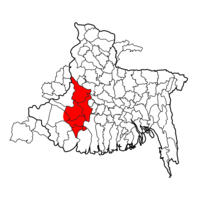West Bengali dialect
| Rarhi | |
|---|---|
| রাঢ়ী | |
 | |
| Native to | India, Bangladesh |
| Region | Presidency Division, Nadia district, Purba Bardhaman district, Hooghly District, Kushtia District, Meherpur District, Chuadanga |
Native speakers | Bengali people of Presidency Division |
Indo-European
| |
| Bengali alphabet | |
| Language codes | |
| ISO 639-1 | bn |
| ISO 639-2 | ben |
| ISO 639-3 | ben |
| Glottolog | cent1983 Central Bengali |
West Bengali or Central Standard Bengali, simply known as Rāṛhī (রাঢ়ী), is the dialect of Bengali language spoken in the southeastern part of West Bengal, in and around the Bhagirathi River basin of Nadia district[1] and the Presidency division in West Bengal, as well as the Greater Kushtia region of western Bangladesh. It forms the basis of the standard variety of Bengali.[2][3][4][5][6]
Geographical boundaries[]
This dialect is prevalent in the West Bengali districts of Kolkata, North 24 Parganas, South 24 Parganas, Nadia, Howrah, Hooghly and Purba Bardhaman. It is also spoken natively in the Chuadanga, Kushtia and Meherpur districts of Bangladesh, which were a part of the Nadia district prior to the 1947 Partition of India. Modern Standard Bengali has been formed on the basis of this dialect.
Features[]
Extensive use of Obhishruti (অভিশ্রুতি, /obʱisrut̪i/). E.g. old Bengali Koriya (করিয়া, /koria/, meaning - having done) > Beng. Koira (কইরা, /koira/) > Beng. Kore (করে, /kore/).[7]
- The change of অ to ও, when অ is the first sound of a word where the অ is followed by ই(ি), ও(ো), ক্ষ or য. E.g. Ati (written অতি, means 'excess') is pronounced as Oti (ওতি, /ot̪i/).
- Use of vowel harmony. E.g. Bilati (বিলাতি, /bilat̪i/, meaning - foreign) became Biliti (বিলিতি, /biliti/).[8]
Obhishruti and Opinihiti[]
Ôbhishruti (অভিশ্রুতি, /obʱisrut̪i/) and Ôpinihiti (অপিনিহিতি, /opinihit̪i/) are two phonological phenomena that occur in spoken Bengali. Opinihiti refers to the phonological process in which a ই or উ is pronounced before it occurs in the word. Obhishruti is the sound change in which this shifted ই or উ becomes removed and changes the preceding vowel. Observe the example above : Koriya (করিয়া, /koria/) > Koira (কইরা, /koira/) > Kore (করে, /kore/). First Opinihiti changes Koriya to Koira (notice how the I changes position.), then Obhishruti changes Koira (কইরা) to Kore (করে).[9]
References[]
- ^ Chakrabarti, Kunal; Chakrabarti, Shubhra (2013). Historical Dictionary of the Bengalis. Scarecrow Press. ISBN 9780810880245.
- ^ Karan, Sudhir Kumar (2004). Thus Flows The Ganges. Mittal Publications. ISBN 9788170999232.
- ^ Calcutta, Philological Society of (1966). Bulletin of the Philological Society of Calcutta. Department of Comparative Philology, University of Calcutta.
- ^ "Praci Bhasavijnan: Indian Journal of Linguistics". Indian Journal of Linguistics. Bhasa Vidya Parishad. 20: 79. 2001.
- ^ Bangladesh Quarterly. Department of Films & Publications, Government of Bangladesh. 2002. p. 6.
- ^ Calcutta, Philological Society of (1966). Bulletin.
- ^ Folk-lore. Indian Publications. 1975.
- ^ SK Chatterji, The Origin and Development of the Bengali Language, Calcutta University, Calcutta, 1926; CP Masica, The Indo-Aryan Languages, Cambridge University Press, Cambridge, 1991.
- ^ Sunitikumar Chattopadhyay (1939) ভাষা-প্রকাশ বাঙ্গালা ব্যাকরণ, Calcutta University
- Eastern Indo-Aryan languages
- Bengali dialects
- Languages of West Bengal
- Languages of Bangladesh